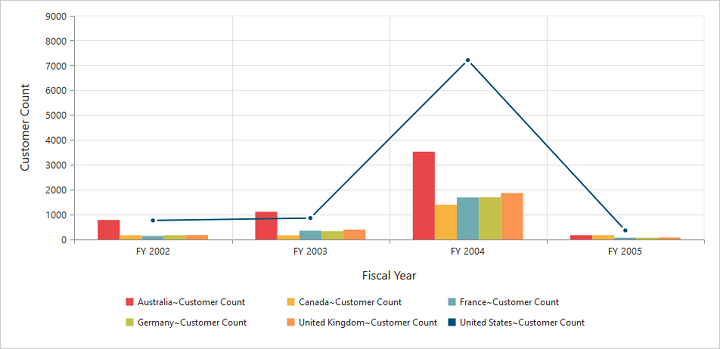Chart Types
28 Sep 201712 minutes to read
Essential PivotChart ASP.NET supports 17 different types of chart as follows:
- Column
- Stacking Column
- Bar
- Stacking Bar
- Pie
- Pyramid
- Funnel
- Line
- Step Line
- Spline
- Area
- Step Area
- Spline Area
- Stacking Area
- Doughnut
- Scatter
- Bubble
Column Chart
Column Chart is the most commonly used chart type. It uses vertical bars (called columns) to display different values of one or more items. Points from adjacent series are drawn as bars next to each other. It is used to compare the frequency, count, total or average of data in different categories. It is ideal to show the variations in the value of an item over a period of time.
<ej-pivotchart [commonSeriesOptions]="commonSeriesOptions" [size]="size">
</ej-pivotchart>//..
export class PivotChartComponent {
public size; commonSeriesOptions;
constructor() {
//..
this.size = { height: "460px", width: "950px" };
this.commonSeriesOptions = { type: ej.PivotChart.ChartTypes.Column };
}
}The following screenshot displays a Column Chart.
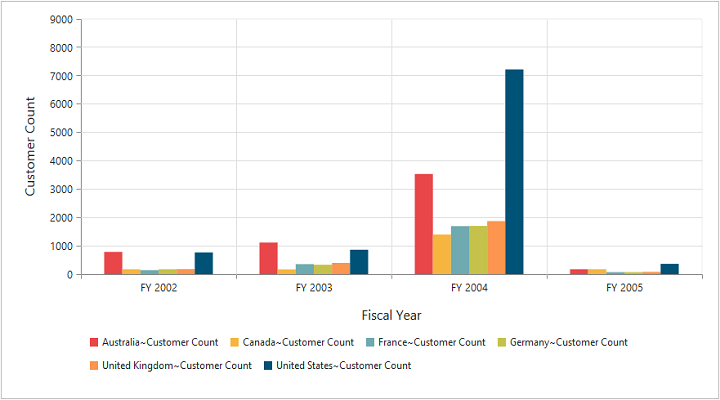
Column chart
Stacking Column Chart
Stacking Column Chart is similar to column charts except the Y-values. These Y-values stack on top of each other in a specified series order. This helps to visualize the relationship of parts to whole across categories.
//..
export class PivotChartComponent {
public size; commonSeriesOptions;
constructor() {
//..
this.commonSeriesOptions = { type: ej.PivotChart.ChartTypes.StackingColumn };
}
}The following screenshot displays the Stacking Column Chart.

Stacking Column Chart
Bar Chart
The Bar Chart displays horizontal bars for each point in the series and points from adjacent series. Bar charts are used to compare values across categories, for displaying the variations in the value of an item over time or for comparing the values of several items at a single point in time.
//..
export class PivotChartComponent {
public size; commonSeriesOptions;
constructor() {
//..
this.commonSeriesOptions = { type: ej.PivotChart.ChartTypes.Bar };
}
}The following screenshot displays a Bar Chart.
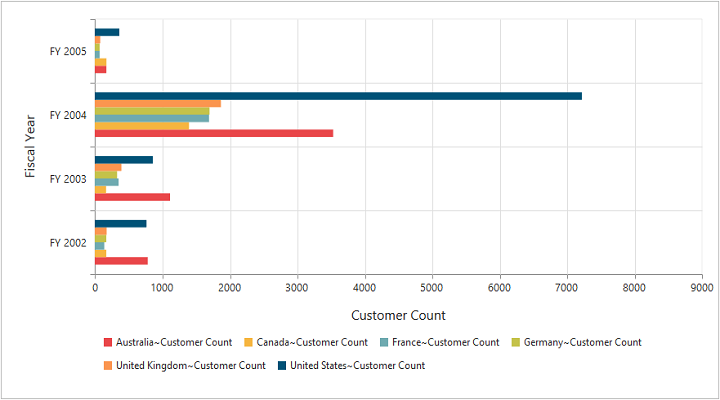
Bar Chart
Stacking Bar Chart
Stacking Bar Chart is a regular bar chart with the X-values stacked on top of each other in the specified series order.
//..
export class PivotChartComponent {
public size; commonSeriesOptions;
constructor() {
//..
this.commonSeriesOptions = { type: ej.PivotChart.ChartTypes.StackingBar };
}
}The following screenshot displays the Stacking Bar Chart.
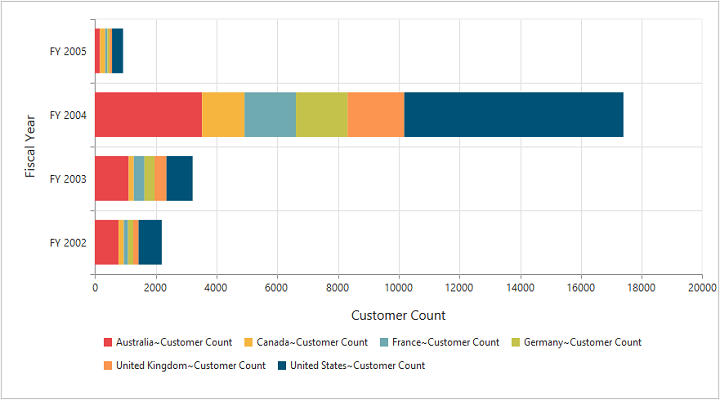
Stacking Bar Chart
Pie Chart
A Pie chart is used to summarize a set of categorical data or displaying different values of a given variable (e.g., percentage distribution). This type of chart is a circle divided into a series of segments. Each segment represents a particular category.
//..
export class PivotChartComponent {
public size; commonSeriesOptions;
constructor() {
//..
this.commonSeriesOptions = { type: ej.PivotChart.ChartTypes.Pie };
}
}The following screenshot displays a Pie Chart.
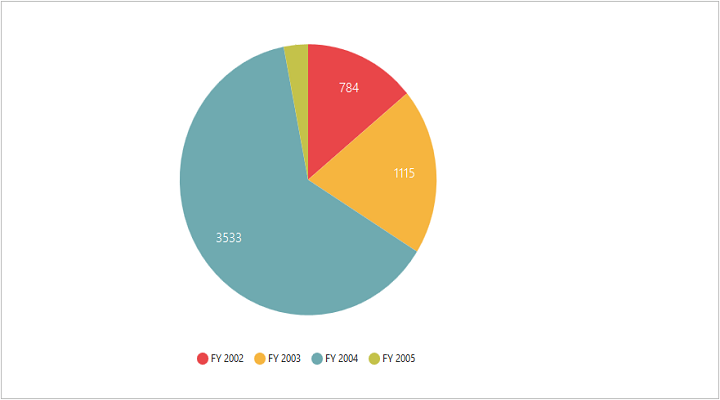
Pie Chart
Pyramid Chart
The Pyramid Chart type displays the data in the form of a triangle. It helps you to visualize data in a hierarchical structure without any axes.
//..
export class PivotChartComponent {
public size; commonSeriesOptions;
constructor() {
//..
this.commonSeriesOptions = { type: ej.PivotChart.ChartTypes.Pyramid };
}
}The following screen shot displays the Pyramid Chart.
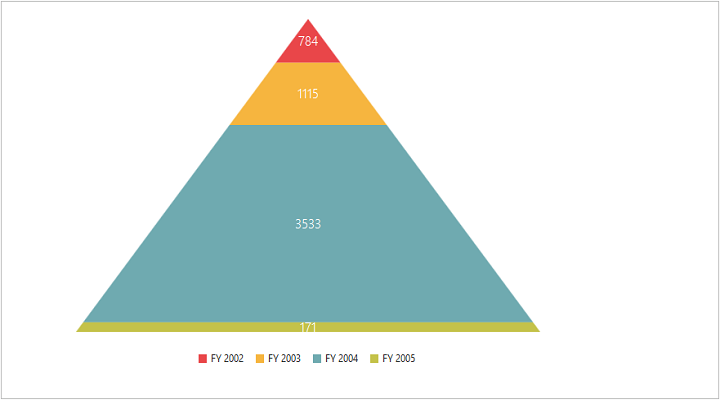
Pyramid Chart
Funnel Chart
The Funnel Chart type displays the data in the form of an inverted triangle. It helps you to visualize data in a hierarchical structure without any axes.
//..
export class PivotChartComponent {
public size; commonSeriesOptions;
constructor() {
//..
this.commonSeriesOptions = { type: ej.PivotChart.ChartTypes.Funnel };
}
}The following screen shot displays the Funnel Chart.
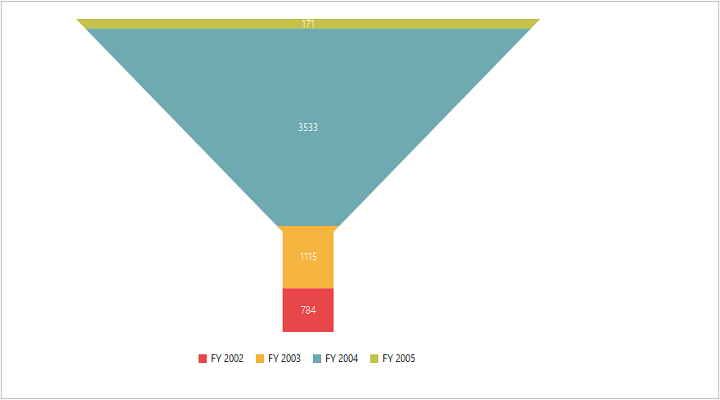
Funnel Chart
Line Chart
The Line Chart joins the data points on a plot using straight lines that show trends in data at equal intervals.
//..
export class PivotChartComponent {
public size; commonSeriesOptions;
constructor() {
//..
this.commonSeriesOptions = { type: ej.PivotChart.ChartTypes.Line };
}
}The following screenshot displays the Line Chart.
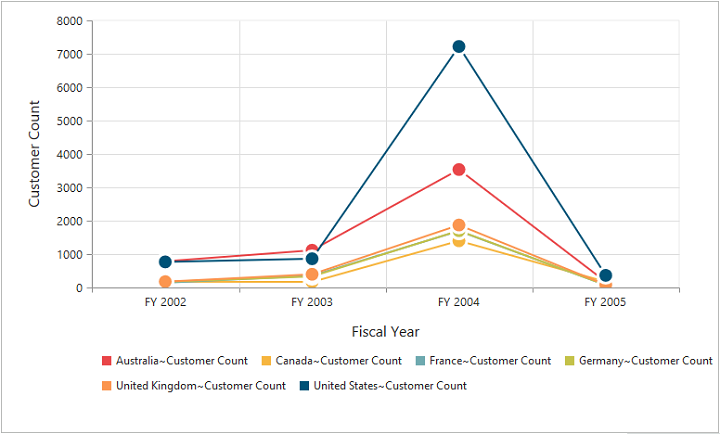
Line Chart
Step Line Chart
Step Line Chart uses horizontal and vertical lines to connect the data points resulting in a step like progression.
//..
export class PivotChartComponent {
public size; commonSeriesOptions;
constructor() {
//..
this.commonSeriesOptions = { type: ej.PivotChart.ChartTypes.StepLine };
}
}The following screenshot displays the Step Line Chart.
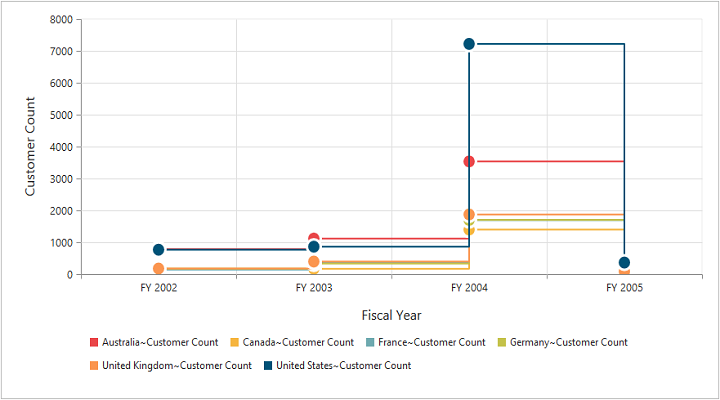
Step Line Chart
Spline Chart
The Spline Chart is similar to line charts except it connects different data points using curve lines instead of straight lines.
//..
export class PivotChartComponent {
public size; commonSeriesOptions;
constructor() {
//..
this.commonSeriesOptions = { type: ej.PivotChart.ChartTypes.Spline };
}
}The following screenshot displays the Spline Chart.

Spline Chart
Area Chart
Area Chart emphasizes the degree of change of values over a period of time. Instead of rendering data as discrete bars or columns, an area chart renders it in a continuous ebb-and-flow pattern as defined against the y-axis.
//..
export class PivotChartComponent {
public size; commonSeriesOptions;
constructor() {
//..
this.commonSeriesOptions = { type: ej.PivotChart.ChartTypes.Area };
}
}The following screenshot displays the Area Chart.
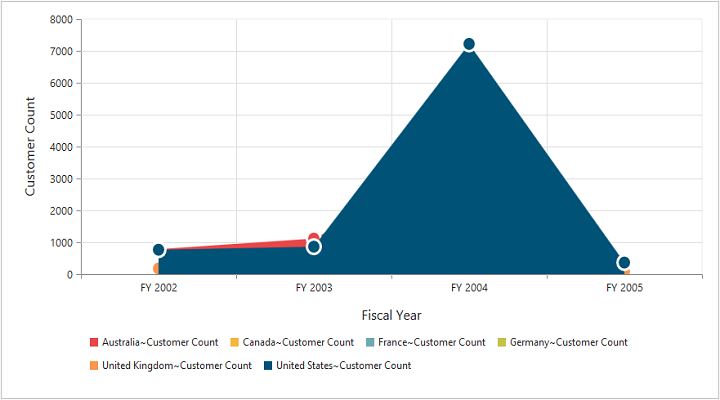
Area Chart
Step Area Chart
Step Area chart is similar to the regular area chart except for a straight line tracing the shortest path between the data points. The values are connected by continuous vertical and horizontal lines forming a step like progression.
//..
export class PivotChartComponent {
public size; commonSeriesOptions;
constructor() {
//..
this.commonSeriesOptions = { type: ej.PivotChart.ChartTypes.StepArea };
}
}The following screenshot displays a Step Area Chart.
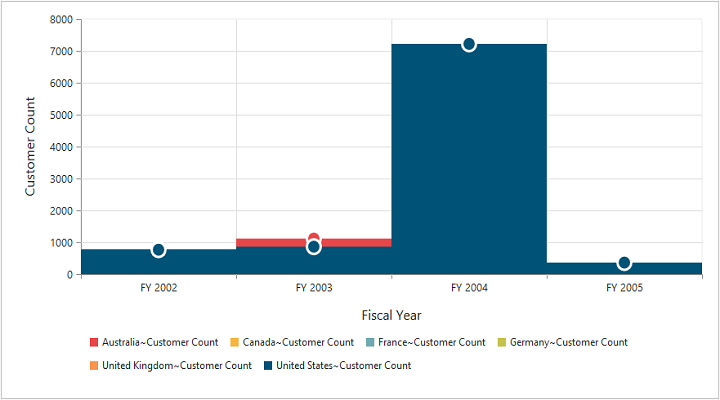
Step Area Chart
Spline Area Chart
Spline Area chart is similar to Area Chart with the difference in which the data points of a series are connected. It connects each series of points by a smooth spline curve.
//..
export class PivotChartComponent {
public size; commonSeriesOptions;
constructor() {
//..
this.commonSeriesOptions = { type: ej.PivotChart.ChartTypes.SplineArea };
}
}The following Screenshot displays a Spline Area Chart.
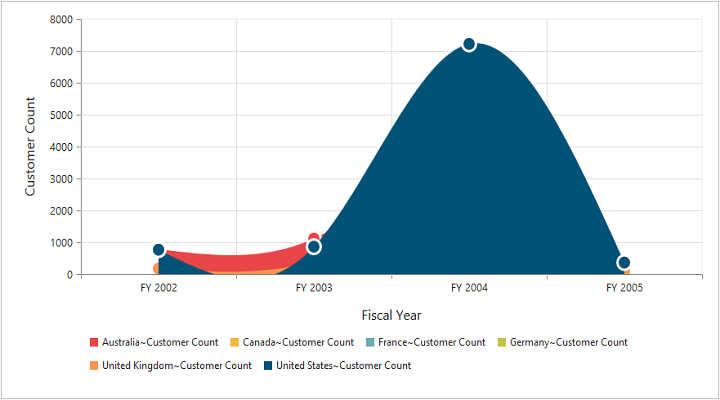
Spline Area Chart
Stacking Area Chart
Stacking Area chart is similar to regular area chart except the “Y-values”. These “Y-values” stack on top of each other in the specified series order. This helps to visualize the relationship of parts to whole across categories.
//..
export class PivotChartComponent {
public size; commonSeriesOptions;
constructor() {
//..
this.commonSeriesOptions = { type: ej.PivotChart.ChartTypes.StackingArea };
}
}The following screenshot displays a Stacking Area Chart.

Stacking Area Chart
Doughnut Chart
A Doughnut chart is also used to summarize a set of categorical data which possesses a doughnut like structure divided into a series of segments. Each segment represents a particular category.
//..
export class PivotChartComponent {
public size; commonSeriesOptions;
constructor() {
//..
this.commonSeriesOptions = { type: ej.PivotChart.ChartTypes.Doughnut };
}
}The following screenshot displays a Doughnut Chart.
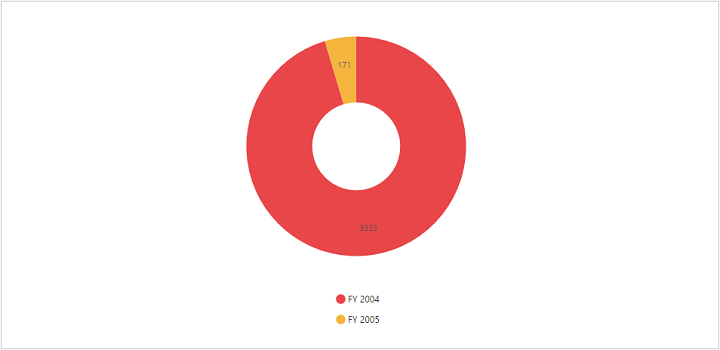
Doughnut Chart
Scatter Chart
The Scatter Chart type displays the data as a collection of points corresponding to the associated values.
//..
export class PivotChartComponent {
public size; commonSeriesOptions;
constructor() {
//..
this.commonSeriesOptions = { type: ej.PivotChart.ChartTypes.Scatter };
}
}The following screen shot displays the Scatter Chart.
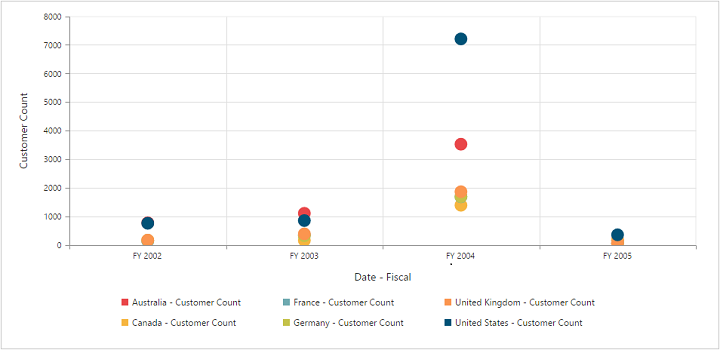
Scatter Chart
Bubble Chart
The Bubble Chart type displays the data as a collection of bubbles.
//..
export class PivotChartComponent {
public size; commonSeriesOptions;
constructor() {
//..
this.commonSeriesOptions = { type: ej.PivotChart.ChartTypes.Bubble };
}
}The following screen shot displays the Bubble Chart.
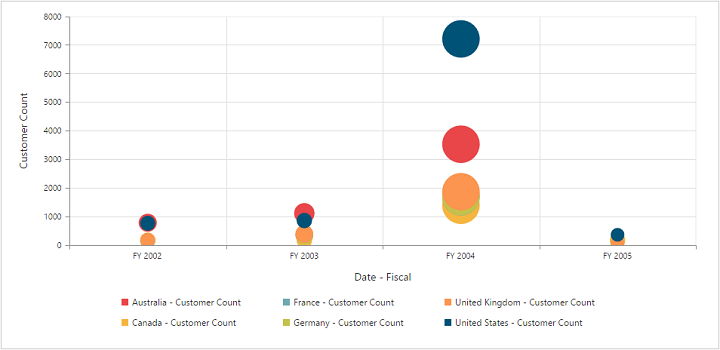
Bubble Chart
Combination Chart
A combination Chart combines two or more series types in a single Chart. But there are some limitations in the combination Chart. They are:
- Can’t combine Column and Bar series.
- Pie Chart can’t be used with other series types.
<ej-pivotchart [commonSeriesOptions]="commonSeriesOptions" [size]="size" (load)="onLoad($event)">
</ej-pivotchart>//..
export class PivotChartComponent {
public size; commonSeriesOptions;
constructor() {
//..
this.size = { height: "460px", width: "950px" };
this.commonSeriesOptions = { type: ej.PivotChart.ChartTypes.Column };
}
onLoad(args) {
args.model.seriesRendering = function (evt) {
this.model.series[5].type = ej.PivotChart.ChartTypes.Column;
this.model.series[5].marker.visible = true;
};
};
}The following screenshot displays a combination Chart.
